Introduction:
“The Year World Caught Fire” is the report published by WWF in December 1997, which has captured the attention of world environmentalist towards the escalating challenge of ‘Forest Fires’. In year 1997-98, the forest fires created the large havoc and results in a big ecological crisis. Since then, the problem has been continually rising. The forests are a prime natural resource and act as natural sink for carbon emission. But ‘Forest Fires’ are not only destroying these resources but also emitting large amount of carbon into atmosphere in form of smoke which contain cocktail of many pollutants such as – hydrocarbons, soot particles, nitrogen oxides and benzene [1]. Thereby, these forest fires have double negative impact on the global ecological balance. A study by European Commission’s Global Vegetation Monitoring Unit revealed that forest fires in severe fire years may contribute up to nearly 40% of the greenhouse emission [2]. However, causes as well as solutions of the forest fires are complex. There are strong evidences that these fires are firmly associated with the climatic and anthropogenic factors [3,4]. The combination of El Niño-induced drought conditions, high winds, deforestation and people burning land as a clearance tool could be included in some the main causes of widespread fires in a particular region. Besides, it seems that temperature is also an important influencer of the wildfires, as observed in Canada and Alaska where higher temperature are ascribed to the greater burnt area [5,6]. The ecological, economical and health related effect of fires cannot be known with accuracy, these can only be estimated. Additionally, the damage and pain inflicted to flora and fauna during these fires can never be expressed and the social impact on the tribal and rural community cannot be neglected. The time of action to control this devastation is also limited as the forests affected by fires become more susceptible to second and subsequent fires which will dramatically increase the impact. Hence, some strong steps are highly recommended and are the need of hour in present scenario.
This article reviews the effect of forest fires that occurred throughout the world in last five years with emphasis on the situation in India. It is summarised that forest fires are found to be increasing in few past years and this increase is most probably associated with the increase in average temperature of the region. A brief description on the behaviour of forest fire is also explained. The principal causes of these fires are illustrated along with the impacts on economic, ecological and social aspects of world population. The precautionary measures that will help to reduce the incidents of fires are also briefed.
The Forest Fire:
Fire is the oldest tool used by the humans for their needs but rampant fire also has been an environmental horror for past hundreds years. Fire is enigmatic – it destroys flora, fauna and biodiversity, leading to ecological imbalance. On the other hand it is extremely beneficial for forest regeneration and replenishment of nutrients. It is probably the cheapest and highly efficient way to clear the land and vegetation. The burning behaviour of fire is attributed to the combustion process in which fuel is oxidised via highly exothermic process. In combustion process, the solid hydrocarbon fuel is first volatilised by pyrolysis and then oxidised with oxygen to give oxides of carbon, nitrogen and sulphur along with unburnt carbon particles as smoke [7]. Likewise, during a forest fire, the forest fuel, which is in solid phase, is initially converted into volatile compounds and this process is termed as pyrolysis which is an endothermic process. Subsequently, the volatile compounds are burnt or oxidised to produce heat, light and energy in addition to lot of smoke. In case of forest fire two types of combustion processes has been identified – Flaming combustion and smoldering combustion [7–9]. Flaming combustion is the process of burning with the formation of flame but in smoldering no flame is produced (Fig. 1). The two processes differ in the rate of pyrolysis occurring over the surface of fuel. Heat evolved during combustion process is transferred to the tree which results in damage of its root, bole and crown. All the forest fires affects the vegetation via heat transfer which occurs through conduction or convection or radiation [10]. Fire has been and will continue to remain a significant component in portraying the forest ecosystem worldwide, as some ecosystems require forest fire for their regeneration whereas others are severely destroyed by it. The correlation amongst humans, fire and forests is a complicated one and has been the concern of innumerable reviews and reports.
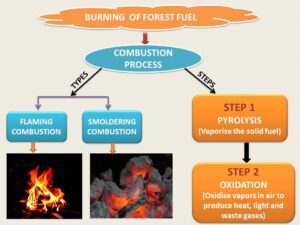
Causes and Impacts:
Fire activity is intensely affected by four factors – climate, availability of fuels, igniting sources and human activities. The causes of forest fire are not well defined however the influence of climate change on the severity of fires has been discussed in various studies. It is estimated by Ahmad et al that >90% forest fires are caused by human activities, deliberately or solely due to inadvertence or just by accident [11]. Additionally, dry season with elevated temperature, strong winds and low humidity, further augment and spread the fires over large areas in uncontrollable manner. Fires may be sparked naturally, most commonly by lightning, or by human activity like unextinguished smoking materials, faulty electrical equipment, overheating automobiles, or arson. Anthropogenic activities are of keen concern which involves deforestation and cleaning of land by burning. The other instances of such activities are collection of non-timber forest produce (NTFP) by igniting the leaves lying on the forest floor as it facilitates the collectors to collect the NTFP, increasing the production of Tendu leaves, to keep the wild animals away, sometimes smugglers start the fire to hide the illicit stock of felling and sometimes due to rivalry with forest staff.
Climatic factors are dynamical, caused by the changes of orbital parameters of earth, solar output and environmental constitution. In recent years, increased emission of greenhouse gases- carbon dioxide, methane etc. in the atmosphere due to human activities, has led to continuous warming of our climate (IPCC 2001). This warming or increased temperature is capable of exhibiting an immediate and intense influence on fire frequency and intensity in the forest zone. Gillett et al. in 2004, have indicated that in last 4 decades, the noted rise in burnt area in Canada is the consequence of human-related climate influenced activities [12]. There is substantial evidence that forest fires increase in number and size consequent to their relation between global climate variations and the climate phenomenon called El Niño (Spanish meaning ‘little child’). The frequency and intensity of El Niño could be increasing, which indicates that the world might faces more warmer and more violent weather leading to more forest fires [13,14] The impacts of El Niño are perceived throughout the world, as it is accountable for the changes in the trade winds, air pressure and precipitation patterns. El Niño specifically affects the tropics by the way of decline in rainfall around the western tropical Pacific and Central & northern South America.
Forest fires not only cause forest degradation but also have vast extending destructive ecological, economic and social impacts. Fires cause loss of biodiversity, loss of habitats of wildlife and extinction of various species of plants and animals. Since forests are an influential natural resource, so their burning results in loss of CO2 sink resource, loss of oxygen resource and loss of valuable timber. The forest fires affect the life of many tribal and rural people whose livelihoods are directly dependant on the collection of NTFP and timber products especially in India where most of the population belongs to rural area. Additionally, the smoke produced from fires pushes lots of pollutants into the atmosphere which influences the lives in many indirect ways such as – ozone depletion, health issues, warming the atmosphere etc. Also, the time of action to check this devastation is confined as the forests affected by fires become more susceptible to second and subsequent fires which will dramatically increase the impact. Thus, to protect this unique planet and its diversity, some swift and substantial steps are required.
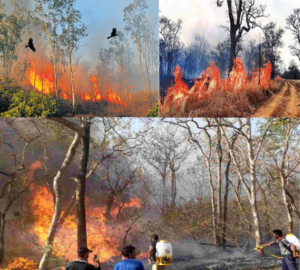
Global devastation caused:
A study published in “Frontier science news” claims that nearly one third of the forest loss globally, between 2001 and 2019 was due to the fires [15]. Global increase in temperature and more dry conditions over the past decades give rise to continuous increase in burnt or damaged area due to forest fires. In past few years, amazon, which is the largest rain forest, has been experiencing more severe dry and hot climate attributed to the increased fires in this region. Satellites in September recorded 32,017 hotspots in 2020, a 61% rise from the same month in 2019. A data from Brazilian Government’s INPE (National institute of Space Research) suggests that number of fires in amazon in 2020 has increased up to 10 times in comparison to 2014. Australia observed “Black Summer” in the year 2019-2020 (the historic wild fire year), when fire burnt more than 11 million hectares land, destroyed more than 3000 buildings and killed 34 people including 4 fire-fighters along with 3 billion animals (Fig. 3). Australia had lost 50 animal and 60 plant species in the past two centuries through wild bush fires, while an approximately 2,000 species of flora and fauna, woodlands, forests and wetlands, are at risk of extinction. Likewise, average burnt area due to these fires has tripled in past decades in U.S. In 2022, 38,046 wildfires have burned 5,571,855 acres of land in the United States. These figures are the maximum for area burned-to-date in the past 10 years. Europe has already witnessed a record destruction due to fires in 2022. In July, 2022 fire hit many countries in Europe: Portugal, Spain, France, Greece. The possible accountability has been given to warm and hot climate prevailing in the present Europe. Data from EFFIS shows that till 23rd July, 2022, more than 515,000 hectares of land had been burned across Europe. This is claimed to be nearly four times the average recorded since 2006, and is twice the previous record observed during this time. Fig. 4 shows the total burnt areas in major countries of world in last 5 years.
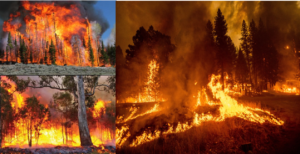
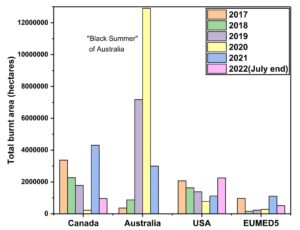
India:
With 63.7 million ha of forest cover, India is one of the richest areas for biodiversity in the world. The Forest Survey of India (FSI) data on forest fire, attributes around 50% of the forest areas as fire prone [16]. Most frequent forest fires occur in between February and May in India indicating the direct link of dry climate and fires. Due to forest fires, India loses Rs1,176 crore annually, as per a report, Strengthening Forest Fire Management in India, jointly prepared by the Ministry of Environment, Forest and Climate change (MoEFCC) and the World Bank. A study by the Council on Energy, Environment and Water (CEEW) claimed that wildfire incidents and total area burned have increased by tenfold between 2000 and 2019. There were 3,082 forest fires across states in year 2000, while the number went up to almost 30,947 in 2019. This manifold increase is associated with the increase in average temperature which is affirmed by the report of IMD (Indian Metrological Department) suggesting the 2011 – 2021 decade as the warmest decade on record. According to FSI, a total of 381 forest fires have been reported in India by the March end, 2022. The recent incident at Sariska forest reserve was the fourth forest fire in that week. Earlier, forest fires would take place during the summer months, i.e. between May and June. But now due to climate change, many forest fire incidents are being reported during spring, between March and May which indicate that the duration of forest fires is now nearly six months which was earlier supposed to be three or four months only. The recent fire at Rajasthan’s Sariska Tiger Reserve was also considered to have been unseasonal, with high temperatures exacerbating the spread of the fire (Fig. 5).
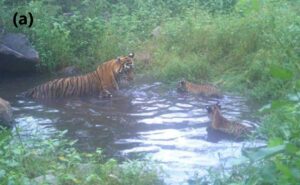
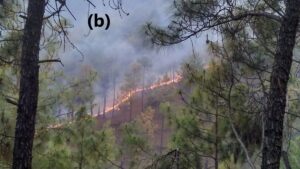
Comparison of the number of fires with that of average temperature in India in last decade (2012 – 2021) is portrayed in Fig 6 and Table 1. The data communicates that the year of higher average temperature reported higher number of forest fires which implies the effect of climate and global warming on the increasing incidents of forest fires.Thus it can be summarised that havoc created by fires is continually increasing in the entire world and it is directly or indirectly related to the global warming and its impacts. Table 1 demonstrates that the maximum temperature is recorded in the year of maximum forest fires. This observation further upholds the dependency between climate change and forest fires. The devastation caused by these fires is alarming for the biodiversity and ecological balance. So we all have to take small and substantial steps to minimise the carbon emission, to decrease the global warming, to lower the temperature and hence, to protect our biologically diverse ecosystem from these catastrophic fires. Few steps that have to be taken well in time are as follows [16]:
- Identifying and outlining every fire susceptible areas and analysing the data-base of wild fire destruction.
- Fire Danger Rating System and Fire Forecasting System should be installed.
- All the precautionary steps are to be taken prior to the commencement of fire season.
- People and workers should be frequently instructed for prevention and control of forest fires
- Attempts should be put to create common cognizance contrary to the harmful consequences of forest fires
- Successful and strict implementation of legal provisions for fire prevention and control.
Table 1: Number of fires and average temperature of India in the decade of 2012 – 2021.
| S.No. | Year | *Number of fires | **Average temperature (℃) |
| 1. | 2012 | 40528 | 24.77 |
| 2. | 2013 | 25061 | 24.65 |
| 3. | 2014 | 26797 | 24.79 |
| 4. | 2015 | 22465 | 24.91 |
| 5. | 2016 | 33664 | 25.27 |
| 6. | 2017 | 35888 | 25.16 |
| 7. | 2018 | 37059 | 25.05 |
| 8. | 2019 | 29547 | 24.95 |
| 9. | 2020 | 22447 | 24.80 |
| 10. | 2021 | 52785 | 25.01 |
*based on FSI report, **based on tradingeconomics.com
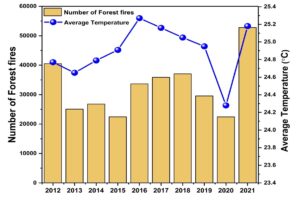
Summary:
This article gives a follow up of damage caused by the wild fires around the few selected countries of world and in India. Forest fires can be either flaming or smoldering type depending on the way of combustion it followed. The forest fuel first volatilises by pyrolysis and then caught fires by the exothermic process of combustion. The causes of these fires could be natural as well as anthropogenic. The fires result in considerable ecological, economical and social losses. The presented data unlocked the continual triggering effect of fires in the recent years which is linked to enhanced dry and hot conditions and subsequently related to global warming of atmosphere. Some substantial and significant steps have to be taken up to protect our biodiversity from getting extinct due to these fires.


